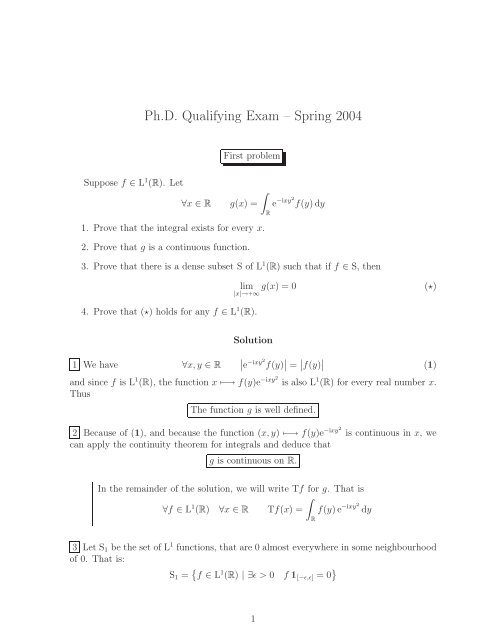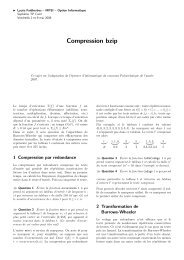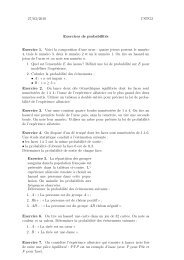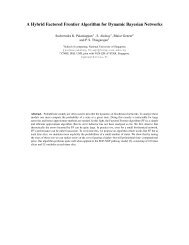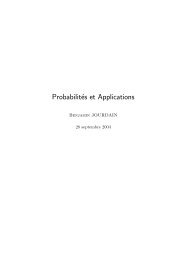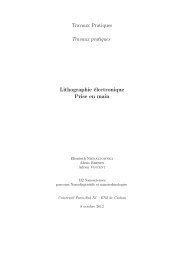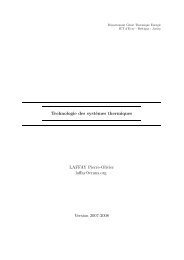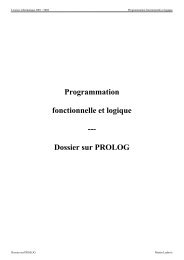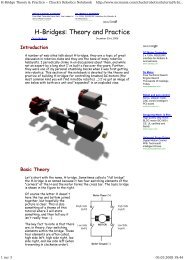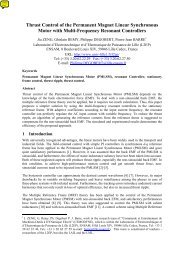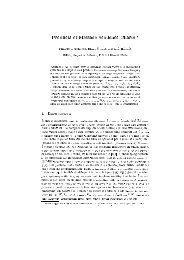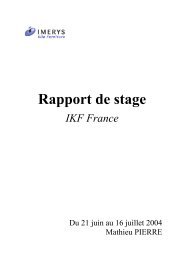Ph.D. Qualifying Exam â Spring 2004
Ph.D. Qualifying Exam â Spring 2004
Ph.D. Qualifying Exam â Spring 2004
You also want an ePaper? Increase the reach of your titles
YUMPU automatically turns print PDFs into web optimized ePapers that Google loves.
<strong>Ph</strong>.D. <strong>Qualifying</strong> <strong>Exam</strong> – <strong>Spring</strong> <strong>2004</strong>First problemSuppose f ∈ L 1 (R). Let∫∀x ∈ R g(x) = e −ixy2 f(y) dy1. Prove that the integral exists for every x.2. Prove that g is a continuous function.3. Prove that there is a dense subset S of L 1 (R) such that if f ∈ S, thenRlim g(x) = 0|x|→+∞(⋆)4. Prove that (⋆) holds for any f ∈ L 1 (R).1 We have ∀x, y ∈ RSolution∣∣e −ixy2 f(y) ∣ ∣ = ∣ ∣f(y) ∣ ∣ (1)and since f is L 1 (R), the function x ↦−→ f(y)e −ixy2 is also L 1 (R) for every real number x.ThusThe function g is well defined.2 Because of (1), and because the function (x, y) ↦−→ f(y)e −ixy2 is continuous in x, wecan apply the continuity theorem for integrals and deduce thatg is continuous on R.In the remainder of the solution, we will write Tf for g. That is∫∀f ∈ L 1 (R) ∀x ∈ R Tf(x) = f(y) e −ixy2 dyR3 Let S 1 be the set of L 1 functions, that are 0 almost everywhere in some neighbourhoodof 0. That is:S 1 = { f ∈ L 1 (R) | ∃ǫ > 0 f1 [−ǫ,ǫ] = 0 }1
We first show that S 1 is dense. Let f be in L 1 . For every positive integer n, definef n = f − f1[− 1 n , 1 n ]Then f n 1 [−1n , 1 n ] = 0so that ∀n ∈ N ⋆ f n ∈ SFurthermore ∀n ∈ N ‖f − f n ‖ 1 =∫ 1n− 1 n|f| −−−−→n→∞ 0which proves that S 1 is dense. We now let S be the elements of S 1 which are C ∞ withcompact support. The intersection of two dense sets is dense, henceS is dense in L 1 (R).If f belongs to S, then h : y ↦−→ f(y) is C ∞ with compact support and 0 in ayneighbourhood of 0. Thus h and h ′ are integrable. We have∫∫∀x ∈ R Tf(x) = f(y) e −ixy2 dy = h(y) ye −ixy2 dyIntegrate by parts:[ h(y)e−ixy 2∀x ∈ R \ {0} Tf(x) =−2ixThus ∀x ∈ R \ {0}R] +∞−∞} {{ }=0R+ 1 ∫h ′ (y)e −ixy2 dy2ix R∣ Tf(x)∣ ∣ 12|x| ‖h′ ‖ 1 −−−−−−→|x|→+∞ 0There is a dense subset S of L 1 such that∀f ∈ Slim Tf(x) = 0|x|→+∞4 Let f be in L 1 and g be in S. We can write that Tf = Tg + T(f − g), and notice that∣∀x ∈ R ∣ T(f − g)(x) ‖f − g‖1Then∣ ∣lim sup ∣ Tf(x) lim sup ∣ Tg(x) +‖f − g‖ 1 = ‖f − g‖ 1|x|→+∞|x|→+∞} {{ }=0This holds for every g in S, which is dense in L 1 . Thus lim sup|x|→+∞∣∣ Tf(x) is 0:∀f ∈ L 1 (R)lim Tf(x) = 0|x|→+∞2
Second problemSuppose (X, A , µ) is a measure space and that (f n ) n∈N is a sequence in L 1 (µ) convergingweakly. Prove that∫(∀ǫ > 0 ∃δ > 0 ∀A ∈ A µ(A) < δ =⇒ ∀n ∈ N |f n | dµ ǫ )SolutionThe following result is a key ingredient for this problem:Theorem 1: Let (X, A , µ) be a measure space. Let f be a positive integrablefunction on X. Then∫(∀ǫ > 0 ∃δ > 0 ∀A ∈ A µ(A) δ =⇒ f dµ ǫ )I believe it is usually proved in 205A, so it can, of course, be used. Yet it took meso much time remembering why it is true that I want to recall the proof:Proof: For every positive integer n, definef n = Min (f, n)The sequence (f n ) n∈N is increasing and converges pointwise to f. By the monotoneLconvergence theorem, f 1 (µ)n −−−−→ f. Let A be a measurable set. We haven→∞∫ ∫ ∫ ∫f dµ = (f − f n ) dµ + f n dµ (f − f n ) dµ + nµ(A)AAATaking n big enough so that ∫ (f −f X n) dµ ǫ , and letting A be any set of measure2less than ǫ yield 2n∫f dµ ǫ□Suppose the conclusion false:∃ǫ > 0 ∀δ > 0 ∃A ∈ AIn other words,Inf{µ(A) ∣ A ∈ A such thatA(µ(A) < δ and∫∫AXAAA|f n | dµ > ǫ for some n ) (⋆)}|f n | dµ > ǫ for some n = 0Start by taking δ 1 = 1 in (⋆). Then there exists an integer k 1 and a measurable set A 1such that3
∫µ(A 1 ) δ 1 and |f k1 | dµ > ǫA 1Let’s rename f k1 to g 1 . This is the first step in the inductive construction of a subsequence(g n ) n∈N of (f n ) n∈N , a sequence (A n ) n∈N of measurable sets, and a sequence (δ n ) n∈N ofpositive real numbers.Suppose that we have constructed the first terms g 1 , . . .,g n of the subsequence, setsA 1 , . . ., A n and positive real numbers δ 1 , . . .,δ n , with the following properties:• For m n, δ m is such that∀A ∈ A(µ(A) δm =⇒• For m n, A m and g m are such thatµ(A m ) δ m∫Aand|g j | dµ < ǫ for j = 1, . . .,m − 1)2m ∫A m|g m | dµ > ǫUsing Theorem 1 and (⋆), it is clear that we can construct δ n+1 , A n+1 and g n+1 . So thetwo properties listed above are actually satisfied for every n. Hope this is clear enough...For every positive integer n, letThe sets (B n ) n∈N are pairwise disjointB n = A n \ ( n−1 ⋃j=1A j)4
Third problemLet f : (a, b) −→ R be an arbitrary function. LetS = { x ∈ (a, b) ∣ ∣ f ′ (x) exists and equals 0 }Prove that the image f(S) of S under f has measure 0.SolutionLet ǫ be a positive real number. By definition, if x is in S, f is differentiable at x andf ′ (x) = 0. Thus there exists h > 0 such that∣∀y ∈ [x − h, x + h] ∣ f(y) − f(x) ǫ|x − y| 2ǫhwhich means that f([x − h, x + h]) ⊂ [f(x) − 2ǫh, f(x) + 2ǫh].Now, let C be the collection of all intervals of the form I = [x − h, x + h] ⊂ (a, b),such that x ∈ S and f(I) is contained in an interval of length at most 2ǫh. What we justexplained shows that C covers S. Thus, by the 5-times covering lemma, there exists apairwise disjoint collection (I n ) n∈N = ( [x n −h n , x n +h n ] ) ⊂ C such that (5I n∈N n) n∈N ⊂ Cas well, and S ⊂ ⋃ 5I n . Thus f(S) ⊂ ⋃ f(5I n ) and since the Lebesgue measure isn∈Nincreasing and subadditive:n∈Nµ ( f(S) ) ∑ n∈Nµ ( f(5I n ) )For every integer n, because 5I n ∈ C , f(5I n ) is included in an interval of length 2ǫ × 5h n :µ ( f(S) ) 5ǫ ∑ 2h n = 5ǫ ∑ ( ⋃ )µ(I n ) = 5ǫµ I n 5ǫ(b − a)n∈N n∈NThis holds for every positive ǫ. Therefore,µ ( f(S) ) = 0n∈N5
Fourth problemLet X be a metric space.1. Prove that if X is countably compact, then X is compact.2. Prove that if every continuous function on X is bounded, then X is compact.Solution1 Suppose that X is countably compact, which means that every countable open cover ofX has a finite subcover. Then we can derive a property analogous to the finite intersectionproperty: if (F n ) n∈N is a (countable) collection of closed sets such that ⋂ F n = ∅, thereexists a finite subcollection F n1 , . . .,F nk such that F n1 ∩ · · · ∩ F nk = ∅.n∈NThis is proven exactly as the finite intersection property is proven: the (F c n) n∈Nform a countable open cover of X. Thus there is a finite subcover F c n 1∪ · · · ∪ F c n kof X, and we have F n1 ∩ · · ·F nk = ∅.Because X is a metric space, sequential compactness is equivalent to compactness. Solet (x n ) n∈N be a sequence of elements of X. The set of limit points of (x n ) n∈N isL = ⋂ {x k | k n}Suppose that L is empty. Then there exist integers n 1 . . . n j such that∅ = j ⋂n∈Nk=1{x k | k n j }But these closed sets form a decreasing sequence, therefore∅ = {x k | k n j }which is, of course, impossible. Hence L is not empty: (x n ) n∈N has convergent subsequences.2 Suppose that X is not compact. There exists a sequence (x n ) n∈N of elements of Xthat has no convergent subsequence. Denote by X the collection (x n ) n∈N . Then X isclosed: indeed, a convergent sequence of distinct points of X would allow us to constructa convergent subsequence of (x n ) n∈N .The same conclusion holds for X n = X \ {x n }, for every integer n: this set is closed.Since it does not contain x n , the distance dist(x n , X n ) is a positive real number r n .6
Define a function on X as follows:∀n ∈ Nf(x n ) = nThen f is continuous on the closed set X and by Tietze’s extension theorem, it can beextended to a continuous function (still denoted f) on X. So there exists a continuous,unbounded, function on X.If every continuous function on X is bounded, X is compact.7
Fifth problemProve that there exists an orthonormal basis B of L 2 ([0, 1]) such that∀f ∈ BLet S =∫ 10|f(x)| dx ∫ 1x < ∞ and f(x) dx x = 0Solution{f ∈ L 2 (0, 1) ∣ ∣∫ 1∀f ∈ S Tf =0∫ 10|f(x)| dx x < ∞ }0f(x) dxxand ∀n ∈ N g n =1 [1n ,1]Then S is dense in L 2 (0, 1). Indeed, let f be an L 2 function. For every positive integer n,the function f n = fg n is in S , andby dominated convergence.Define now‖f − f n ‖ 2 2 = ∫ 1n0Z = Ker Tf(x) dx −−−−→n→∞ 0and let’s show that Z is dense in S . For this, we will need the value of Tg n , which isnot a problem:∀n ∈ N Tg n =∫ 1Let f be any function in S . Then(T f − Tf )g n = 0Tg n1ndxx= ln n −−−−→n→∞ +∞which givesButand thereforef − TfTg ng n ∈ Z|Tf||Tg n | ‖g n‖ 2 = Tf (1 − 1 )−−−−→ln n n0n→∞(lim f − Tf )g n = fn→∞ Tg n8
f is indeed the limit of a sequence in Z : the latter is dense in S .Since L 2 (0, 1) is separable, Z has a countable dense subset X . Using the Gram-Schmidt process, we can extract an orthonormal sequence (f n ) n∈N ⊂ X , that spans thesame subspace as X . ThusX ⊂ Span (f n ) n∈NandL 2 (0, 1) = Span (f n ) n∈N9
Sixth problemLet (X, B, µ) be a finite measure space. Suppose that (f n ) n∈N is a sequence of functionsin L 1 (µ), converging almost everywhere to an L 1 (µ) function f. Suppose also that‖f n ‖ 1 −−−−→ ‖f‖ 1n→∞∫1. Prove that for every measurable set A, |f n | dµ −−−−→n→∞2. Prove that ‖f n − f‖ 1 −−−−→n→∞ 0. SolutionA∫A|f|.1 For every integer n, defineg n = Min (|f n |, |f|) = |f n| + |f| − ∣ |fn | − |f| ∣ 2Since (f n ) n∈N converges almost everywhere to f, it follows that (g n ) n∈N converges almosteverywhere to |f| and is dominated by |f|.Let A be any measurable set. Then (g n 1 A ) n∈N converges almost everywhere to |f|1 Aand is dominated by |f|1 A . The dominated convergence theorem implies that∫ ∫limn→∞The same argument shows thatlimn→∞∫AXg n dµ =∫g n dµ =AX|f| dµ|f| dµNow, by definition of g n , the function |f n | − g n is nonnegative for every integer n andthus we have0 ( )|f n | − g n 1A |f n | − g n∫so that0 ∫( )|fn | − g n dµ ( )|fn | − g n dµA∫XBoth terms on the righthandside tend to |f| dµ, thusX∫(|fn | − g n ) dµ = 0So∀n ∈ N∫Alimn→∞∫|f n | dµ =AA(|fn | − g n)dµ +∫Ag n dµ −−−−→n→∞∫A|f| dµ10
2 For every integer n, the function |f n | + |f| − |f n − f| is nonnegative, by the triangularinequality. Thus Fatou’s lemma applies:∫(lim inf |fn | + |f| − |f n − f| ) ∫(dµ lim inf |fn | + |f| − |f n − f| ) dµn→∞n→∞XSince (f n ) n∈N ∫ converges almost everywhere to f, we can actually simplify the lefthandside.(And since |fn | + |f| ) ∫dµ does converge to 2 |f|, we can pull it out of the liminf onXthe righthandside, after taking limits:∫ ∫ ( ∫2 |f| 2 |f| + lim inf −X Xn→∞X∫( ∫Hence lim sup |f n − f| dµ = − lim inf −n→∞n→∞XXXX)|f n − f| dµ)|f n − f| dµ 0andlim ‖f n − f‖ 1 = 0n→∞We used here the following manipulation involving liminfs:Lemma: If (u n ) n∈N and (v n ) n∈N are two sequences of real numbers such that thefirst one converges to some u ∈ R, we havelim inf (u n + v n ) = u + lim inf v nn→∞ n→∞Note that in general, if we don’t assume that (u n ) n∈N converges, then all wecan say is thatlim inf (u n + v n ) lim inf u n + lim inf v nn→∞ n→∞ n→∞which is not sufficient for us to solve the problem.Proof: Define∀n ∈ NU n = Infkn u kV n = Infkn v k and w n = Infkn (u k + v k )so thatlim infn→∞u n = limn→∞U n = ulim infn→∞v n = limn→∞V nandlim infn→∞ (u n + v n ) = limn→∞w nLet ǫ be a positive real number. Then there exists an integer N such that∀n Nu − ǫ < u n < u + ǫLet n be an integer bigger than N, let k be an integer bigger than n. Then we havein particularu k + v k < u + ǫ + v k11
Butu k + v k Infpn (u p + v p ) = w nThereforew n < u + ǫ + v kThis holds for every k n, so taking the infimum over k yields∀n NLet n tend to ∞ in order to obtainw n < u + ǫ + V nlim inf (u n + v n ) u + ǫ + lim inf v nn→∞ n→∞Since this holds for every positive ǫ, we getlim inf (u n + v n ) u + lim inf v nn→∞ n→∞But the converse inequality holds in general, as stated earlier. Hencelim infn→∞ (u n + v n ) = u + lim infn→∞ v n □12
Seventh problemSuppose that (f n ) n∈N is a decreasing sequence of continuous functions on [0, 1], convergingpointwise to a continuous function f. Prove that the convergence is uniform.SolutionLet ǫ be a positive real number. Define∀n ∈ N O n = { x ∈ [0, 1] ∣ ∣ fn (x) − f(x) < ǫ }The sequence (f n ) n∈N is decreasing. Thus, if p < n are integers, and x is in O p , wehavef n (x) − f(x) < f p (x) − f(x) < ǫwhich proves that x ∈ O n . So the sequence (O n ) n∈N is increasing.Since the (f n ) n∈N ’s and f are continuous, all the (O n ) n∈N ’s are open. Because (f n ) n∈Nconverges pointwise to f, every x ∈ [0, 1] belongs to at least one of these sets. So (O n ) n∈Nis an open cover of the compact set [0, 1]. Thus there is a finite subcover: there existintegers n 1 · · · n k such that[0, 1] = ( O n1 ∪ · · · ∪ O nk)⊂(Onk ∪ · · · ∪ O nk)= OnkBut using again the fact that the (O n ) n∈N are increasing, we get∀n n k[0, 1] = O nIn other words ∀n n k ∀x ∈ [0, 1] 0 f n (x) − f(x) < ǫConclusion (f n ) n∈N converges uniformly to f.13
Eighth problemLet (c n ) n∈N be a sequence of complex numbers. Assume there are positive integersN k −−−−→ ∞ such that the trigonometric polynomialsk→∞P k (t) =∑N k (1 − |j| )c j e ijtNj=−N k + 1kare nonnegative for all t. Prove that there exists a positive measure µ on T such that∫∀n ∈ Z c n = e −int dµ(t)TSolutionFor every integer k, let µ k be the measure with density P k relatively to the Lebesguemeasure. Then µ k is a positive measure and∫‖µ k ‖ = µ k (T) = P k (t) dt = 2πc 0So (µ k ) k∈N is a bounded sequence in M (T) (the Banach space of signed measures on T).1Up to multiplying the (µ k ) k∈N by the constant2πc 0, we can assume that ‖µ k ‖ = 1.Since M (T) is the dual of the separable Banach space C (T) (this is Riesz’ representationtheorem), the unit ball of M (T), together with the topology ⋆ − σ ( C (T), M (T) ) ,is metrizable. And by Banach-Alaoglu-Bourbaki, it is also compact. Thus any boundedsequence there, such as (µ k ) k∈N , has a weak-⋆ convergent subsequence. So we can assumealso that (µ k ) k∈N converges weakly to a measure µ. In particular, we have∫∀n ∈ N e −int dµ(t) = lim P k (t) eTk→∞∫T−int d⎧ButHence∀k ∈ N∫T⎨P k (t) e −int dt =⎩∀n ∈ Z∫TT(1 − |n|N k + 1e −int dµ(t) = c n0)if N k < nc n if N k n14
Ninth problemLet X be a vector space.1. Prove that X has a Hamel basis (or algebraic basis).2. If X is an infinite dimensional Banach space, prove that any Hamel basis must beuncountable.Solution1 Remember that a finite collection (x 1 , . . .,x n ) of vectors in X is called linearly independentif and only if( ∑n )∀(λ 1 , . . .,λ n ) ∈ K n λ k x k = 0 =⇒ λ 1 = · · · = λ n = 0k=1A set L ⊂ X is called linearly independent if and only if every finite subset of L is linearlyindependent. A Hamel basis for X is a linearly independent subset of X that spans X.DefineL = {L ⊂ X | L linearly independent}L is partially ordered by inclusion. Let L ′ ⊂ L be totally ordered, that is: every twoelements of L ′ can be compared and considerL = ⋃L∈L ′ LLet’s show that L ∈ L , or in other words, that L is linearly independent. Let {x 1 , . . .,x n }be any finite subset of L. Then∀k ∈ {1, . . ., n} ∃L k ∈ L ′ x k ∈ L kSince L ′ is totally ordered, we can suppose, up to renaming the x’s, that L 1 ⊂ L 2 ⊂· · · ⊂ L n . Therefore, {x 1 , . . .,x n } ⊂ L n is linearly independent. Which proves that L islinearly independent. Thus we showed that L is inductive: every totally ordered subsetL ′ of L has an upper bound.By Zorn’s lemma, L has a maximal element: there exists a maximal linearly independentfamily B in X. Let’s check that B is a basis. Of course, by definition, B is linearlyindependent. If x ∈ X is not in Span B, then B ( B ∪ {x} ) ∈ L , which contradicts themaximality of B.Span B = X: X has a Hamel basis.15
2 Let X be an infinite dimensional Banach space and suppose it has a countable Hamelbasis (x n ) n∈N ⋆. Letso that∀n ∈ N ⋆ X n = Span (x 1 , . . .,x n )X = ⋃n∈N ⋆ X nEach X n is closed. Indeed, let (u p ) p∈N be a sequence in X n , converging to some u ∈ X.Then (u p ) p∈N is Cauchy; but we know that finite dimensional vector spaces are complete,thus (u p ) p∈N has a limit v ∈ X n . By unicity of the limit, u = v and therefore u ∈ X n .By Baire’s lemma, there has to be a positive integer N such that X N has nonemptyinterior: there exists x ∈ X N and ǫ > 0, such that B(x, 2ǫ) ⊂ X N . We should deduce fromthis that X N = X. Let y ∈ X be nonzero. Then x + ǫ y is in the ball B(x, 2ǫ) ⊂ X ‖y‖ N.Therefore, since X N is a vector space,[ ‖y‖y =ǫwhich proves(x + ǫ‖y‖ y )− ‖y‖ǫ x ]∈ X NX ⊂ X NSo X is finite dimensional and we have a contradiction.A Hamel basis for an infinite dimensional Banach space is uncountable.16
Tenth problemSuppose f : R −→ R is a bounded function such that∣∃K > 0 ∀x, h ∈ R ∣f(x + h) + f(x − h) − 2f(x) ∣ K|h|Prove that∀x, y ∈ R∣ (∣ f(x) − f(y) c 1 + ln + 1)|x − y||x − y|where c is a constant depending only on K and ‖f‖ ∞ .SolutionFix an x ∈ R and define∀z ∈ Rg(z) = f(z + x) − f(x)Then g(0) = 0 ‖g‖ ∞ 2‖f‖ ∞and ∀z, h ∈ R∣ ∣ ∣∣ g(z+h)+g(z −h)−2g(z) = ∣f(z+x+h)+f(z+x−h)−2f(z+x) K|h| (1)Fix a z ∈ R, let n be any integer; by (1):∣ g(2 n z + 2 n z) + g(2 n z − 2 n z) − 2g(2 n z) ∣ ∣ 2 n K|z|or∣ g(2n+1 z)− g(2n z)∣ ∣∣ K|z| 2 n+1 2 n 2after dividing both sides by 2 n+1 . This is true for every integer n, therefore we can sumall these inequalities between n = 0 and n = N − 1 for some positive integer N:∑N−1∣n=0( g(2 n+1 z)2 n+1 − g(2n z))∣ ∣∣∑N−1 ∣ g(2n+1 z)− g(2n z)∣ ∣∣ KN|z| 2 n 2 n+1 2 n 2n=0The lefthandside is a telescoping series and we are left with∣ g(2N z)− g(z) ∣ KN|z|2 N 2Now use the triangle inequality |a − b| |a| − |b|:∣ g(2 N z) ∣ |g(z)| − KN|z|2 N 2and finally|g(z)| ‖g‖ ∞2 + KN|z|N 2 2‖f‖ ∞+ KN|z|2 N 2(2)17
We consider now two cases, depending on |z|:• If |z| 1: Just take N = 1 in (2) in order to get∣∣ g(z) ‖f‖∞ + K|z| ( ‖f‖ ∞ + K )|z|2 2• If |z| < 1: Choose N to be the only positive integer such thatthat isand see what happens in (2):1 1< |z| 2N+1 N ln 1/|z|ln 22 N< N + 1∣ g(z)∣ ∣ 4‖f‖∞ |z| + K|z|2 ln2 ln 1|z|Letting c be some bigass constant, for example(Kc = Max 4‖f‖ ∞ ,2 ln2 , ‖f‖ ∞ + K )2we get an inequality that combines both cases:∣ ∣ ∣ (∀x, z ∈ R ∣ g(z) = ∣f(x + z) − f(x) c 1 + ln + 1 )|z||z|18


